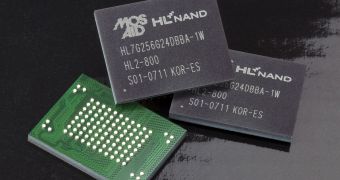Saying that a product is the best at something is a bold statement, but MOSAID is mostly justified in its claim that the 256Gb HLNAND2 (HyperLink NAND) is the fastest in the industry.
After all, a chip that can work at 800 MB/s is not about to go by unnoticed, especially with a capacity of 256 Gb.
The HLNAND2, as it is called (HyperLink NAND) is twice as fast as any other NAND Flash devices and, when DuplexRW is factored in, 1,600 MB/s throughput.
To clarify, the DuplexRW doesn't so much double data rates as it allows read and write operations to be done at the same time, using the PCIe duplexing feature.
A high-speed, point-to-point ring topology is utilized, as opposed to a parallel bus structure, which limits transfer rates to 200 - 400MB/s.
“HLNAND's point-to-point interface creates an extremely clean signaling environment with reduced loading, allowing developers to build SSDs with Terabyte-class capacity without data-rate degradation,” said Jin-Ki Kim, vice president of R&D, MOSAID.
“HLNAND's ring topology also eliminates the need for power hungry on-die terminations that plague variants of parallel-bus Flash.”
Obviously, the newcomer will be used in solid state drives, though not just any drives.
Since it is so much faster than everything else, and since it enables drives with over 1 TB capacity, it will best serve as part of supercomputers and enterprise data centers.
The Built-in EDC (Error Detection Code) and the power savings enabled by automatic packet truncation contribute a lot in those scenarios.
“We are very excited to be the first company to produce a NAND Flash device that delivers DDR800 performance,” said Jin-Ki Kim, vice president of R&D, MOSAID.
“The 256Gb HLNAND2 device is optimized for a wide range of Flash storage applications that require high performance and scalability. We believe that HLNAND2 provides the industry's most cost-effective solution for Flash storage applications requiring both high performance and memory capacity.”

 14 DAY TRIAL //
14 DAY TRIAL //